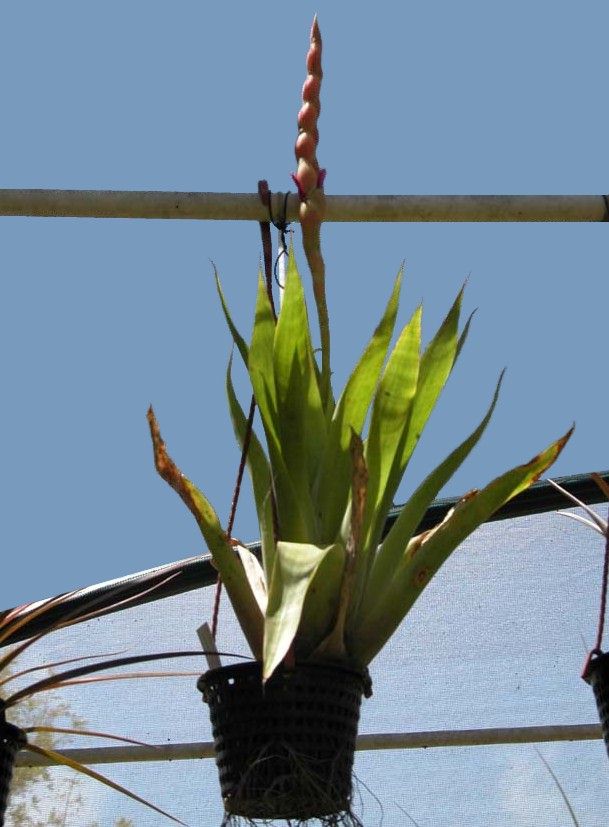
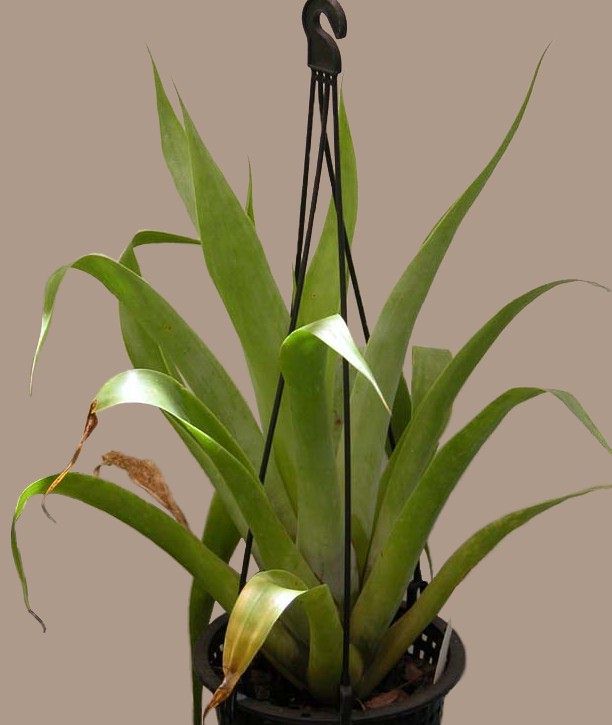
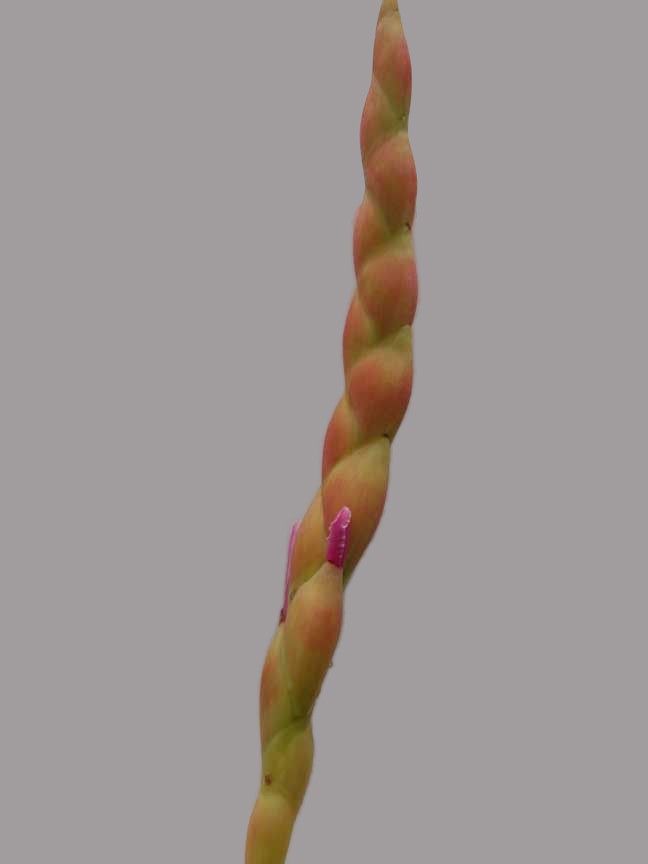
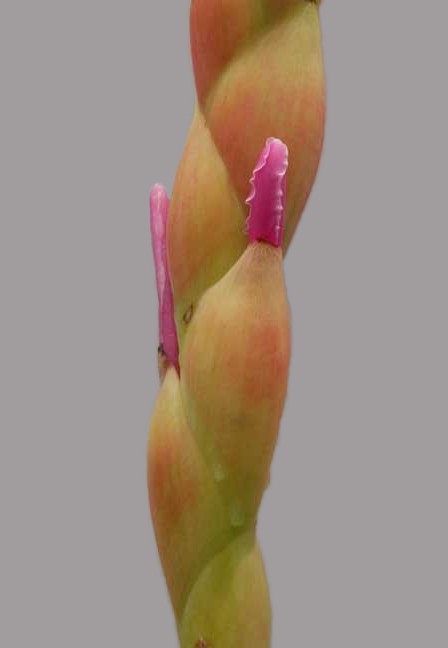
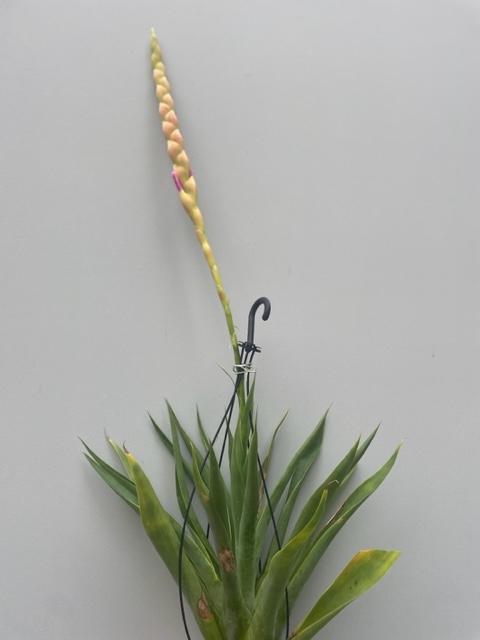



Tillandsia walteri Mez var walteri W Rauh Trop. Subtrop. Pflanz. 21: 34-41. 1977
Plant stemless, flowering 5-7 dm high.
Leaves many in a dense utriculate rosette with almost bulbose base, cinereous-lepidote;
Sheaths longer than the blades, narrowly ovate;
Blades narrowly triangular, tapering to a long narrow tip, rarely with edges rolled inwards, 2 dm long, 4 cm wide.
Scape erect, stout, about equaling the leaves;
Scape-bracts imbricate, broadly elliptic, densely lepidote, rigid, nerved, the lower ones caudate.
Inflorescence simple, dense, distichously 12-16-flowered, lanceolate, 2 dm long, 4 cm wide, but slightly complanate;
Rhachis straight, alate, glabrous.
Floral bracts imbricate and concealing the rhachis, broadly elliptic, obtuse, 5 cm long, exceeding the sepals, inflated, ecarinate, coriaceous, faintly nerved, sparsely and obscurely punctulate-lepidote, roseate drying to allutaceous;
pedicels stout, 4 mm long.
Sepals equally subfree, obtuse, 40 mm long, ecarinate, thick-chartaceous, nerved, glabrous;
Petals 60 mm long, violet;
Stamens included.
Type Weberbauer 4319 (B, F photo 11535), south of Chachapoyas, Aillazonas, Peru, 10 Jul 1904.
DISTRIBUTION. Terrestrial, North Peru
Tillandsia walteri Mez var. herrerae W Rauh Trop. Subtrop. Pflanz. 21: 34-41. 1977
Tillandsia herrerae Harms, Notizbl. Bot. Gart. Berlin 10: 215. 1928. Type. Vicinity of Cuzco, Peru, F. L. Herrera 181 (B, F photo 11501).
Differs from Type in
Leaves few in number, making a lax, funnel to tubular rosette.
Leaves sub-ligulate, smooth, dark to light green, occasionally flecked wine red, shiny, glabrous, and frosted chalky waxy.
Habitat Epiphytic, South Ecuador to South Peru
Notes
Tillandsia walteri MEZ by Rauh in Trop. Subtrop. Pflanz. 21: 34-41. 1977
Collected by A. B. Weberbauer (Collection # 4319 = Type), at "pre-anthesis" on the way south from Chachapoyas (Dptm. Amazonas), and described by C. Mez 1906 in Repert. Nov Species 3, p. 43.
From the original diagnosis, the stemless plant, flowering to 50-80 cm high, forms a compact to 30(-40) cm high tubular rosette with dense grey lepidote ("cinerio lepidotissima") leaves, whose sheath on the upper side is long and violet, is narrow-triangular, blade to 20 cm long, at the base to 4 cm wide, tapering to a narrow tip, and the edges rolled under (fig. 18, left). The erect scape, densely covered by lepidote scape bracts carries a simple, lanceolate, convex on both sides, 12-16-flowered inflorescence. The violet flowers standing on the rhachis, from 40-50 mm long, ecarinate, convex on both sides, raspberry-red floral bracts, which far exceed the ecarinate sepals. The petals are only little bent over at the top; stamens and style deeply inclosed in the flower.
The Type herbarium specimen is in the Botanical Museum at Berlin-Dahlem ( fig. 18, left).
On our trip to North Peru in 1976, we found in about the same area and at an similar location on the way to Chachapoyas from Mendoza, near the type locality of Tillandsia roetingii, a waxy Tillandias in a large group (fig. 19, below) Coll. # Rauh 40106, that was called spontaneously by our accompanying Native Americans as "Choclos", (Chocloses are cooked in Peru from corncobs with the hulls removed).
Indeed, most resembled the rich young rosettes, with their grey papery dried leaves like unhulled corn cobs. The rosettes themselves are slightly bulbous at the base and very compact; from dense overlapping leaves, that have a wide, upper side violet sheath merging into a narrow triangular, long acuminate, with edges rolled under, both sides dense lepidote blade (fig., 20, left; fig. 23, above). Those at the locality had rosette leaves merging together somewhat like they do in cultivation (fig. 22 II).
First we believed we had found a new species, on the basis of the structure of the inflorescence near the type of Tillandsia walteri, all the more so, as we could not determine our plant (No 40106), as T. walteri from the Tillandsia Table of L. B. Smith, (Phytologia No. XX, 3, 1970), where one must look at glabrous leaves in order to reach this. As advised in Mez's diagnosis and in fig. 23, shows these are densely scaled. On the basis of these characteristics we must consider our plant as Tillandsia petraea, that is treated by Smith as a Vriesea today. Moreover it has a chestnut brown sheath and green flowers. Using Subkey IX the leaves must be lingulate as well as sublingulate, you reach Tillandsia walteri, however for Plant Nr. 40 106 these are extremely narrow-triangular.
A comparison of our No. 40106 with the Weberbauer's type specimen (fig. 18, left), shows a certain similarity in both plants as to growth and leaf form as well as scales, and accordingly our plant corresponds to the typical Tillandsia walteri, and we had collected it in the same area and a similar location. They grow up there on lichen encrusted sandstone-rocks in degraded Jalca-bush, that richly covered with Melastomataceae (Tibouchina), Ericaceae, (Cavendishia, Befaria and others.), Embothrium (Proteaceae), shrubby Orchidaceae (Sobralia and Epidendrum-species, Pleurothallis with highly succulent leaves, Eriocaulaceae (3 species), and others.
Other Bromeliads we saw were Tillandsia adpressa and a straw-like floral bracted deviant form of Vriesea olmosana. The conspicuous offsets of T. walteri are remarkable, that appear in groups (fig. 19, below). They only grow terrestrially.
These plants are wide spread not only in our collections but also in Peru and South Ecuador and that after the Table of L. B. Smith you can determine without difficulty as T. walteri, however in contrast to our T. walteri (40106) it always grows only epiphytic in single plants and after flowering only produces 1 to 2 offsets maximum? The locality area stretches from South Ecuador to South Peru.
The following locations are known from the literature and on the basis of our own collections:
Ecuador: C u e n c a - O n a (Prov. Azuay), ca. 4000 m, coll. Foster 2617;
Hazienda Pizhin (Prov. Azuay), 2800 m, coll. Asplund 17711;
Saraguro - Loja (Prov. Azuay), 2750 m, coll. Rauh 35 155 / Sept. 73;
Tal des Rio Zamora (Prov. Zamora), 2000 m, coll. Rauh 35 263 Sept. 73;
Peru : Tarma (Dptm. Junin), 2700 m, coll. Rauh 21221 /Okt. 67;
Tarma (Dptm. Junin), 2700 m, coll. Rauh 23 675 / July 70;
Huambos (Dptm. Cajamarca), 2400 m, coll. Rauh 24 252 / July 70;
10 km sudlich Ayacucho (Dptm. Ayacucho), 3200 m, coll. Rauh 25 935 / Aug. 71;
Urubambatal near Pisak (Dptm. Cuzco), 2700 m, coll. Rauh 26 144a / Sept. 71;
Paurcatambo (Dptm. Cuzco), 2700 m, coll. Rauh 26 244 / Sept. 71;
Quebrada Yancanuco, Cord. Blanca (Dptm. Ancash), 4000 m, coll. Rauh; 38 748 / Okt. 75 und 40 454 / Aug. 76;
Oberhalb Balsas, Maranon - Tal (Dptm. Cajamarca), 3400 m, coll. Rauh 40 454.
All plants show the growth, as in fig. 21 and fig. 22. The sublingulate, long acuminate, glabrous, dark - to light green, occasionally red flecked and waxy frosted leaves form a very lax rosette, whose outer leaves soon dry off like paper. Clearly the construction of the inflorescence, its large size, ecarinate, raspberry red floral bracts and the pale violet flowers are only insignificant contrasts to the depicted above T. walteri Weberbauer 4319 and Rauh 40106.
In 1928, Harms described in the Journal of the Berlin Botanic Gardens 10, 1928, p., 215-216 T. herrerae, that had been collected by Herrera in the area near Cuzco under the numbers 181,(1923) and 1195 (1926). A comparison of the herbarium specimens in the Berlin museum (fig. 18, right), with the above collections, especially those written about yielded a clear similarity, so that these wide spread plants in habitat and in collections are true T. herrerae. Probably because of same inflorescence and floral structure, L. B. Smith in "Flora of Peru, Vol. XIII, 1936, p. 55" made T. herrerae synonymous to T. walteri, an opinion, with which we agree no longer today. At least, T. herrerae should be treated as a variety of T. walteri, and I propose this species has two varieties:
var. walteri
(Type Weberbauer 4319, Botan. Museum, Berlin; as well as Rauh 40106 / Aug 76)
Leaves very numerous, forming a compact, at the base almost bulbose, utriculate rosette. Leaf blades narrow-triangular, tapering to a long, narrow tip, densely scaled, rolled at the edges, rare; terrestrial. Until now only known from North-Peru (Chachapoyas), ( Fig. 18, left; fig. 19; fig. 20; fig. 22, II; fig. 23, above).
var. herrerae (Harms) Rauh nov comb. (= T. herrerae Harms, 1928 = T. walteri L. B. Smith p. p. 1936).
Leaves less numerous, forming a lax, funnel to tubular rosette; leaves sublingulate, flattened, dark to light green, occasionally red blotched, appearing glabrous and chalky waxy coating.
Abundant in South Ecuador to South Peru, growing epiphytically (Type F. L. Herrera 181, Botan. Museum, Berlin; fig. 18, right; . also fig. 21; fig. 22, I; fig. 23, below.) There are particular differences between the two varieties when leaf sections are examined uder an electron-microscope:
The leaves of var. walteri have a dense edge of very large scales with the formula 4, 8, 16, 64 (fig. 23, above) the leaves of var. herrerae however points out only few, very small scales which for a Tillandsia have the rare formula 4, 8, 16, where the wings are very short.
These differences, and the fact that examinations of all collected plants have shown a certain consistency, justifies raising, despite the same inflorescence and floral structure, T. herrerae into the position of a variety of T. walteri.
Date: Tue, 16 Feb 2010
From: Uwe Scharf
Subject: Tillandsia walteri
I think I found the solution some days ago in Rauh (1990). Bromelien ...
Some research must have been done before ... he says that it was named after a German botanist from Knigsberg (Ostpreuen), which is now Russia (Kaliningrad).
Uwe